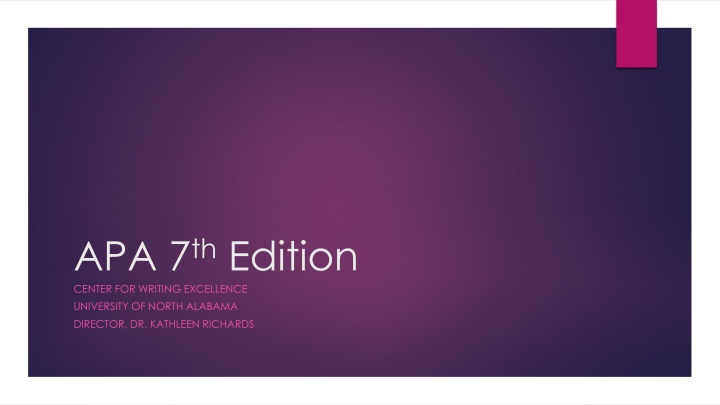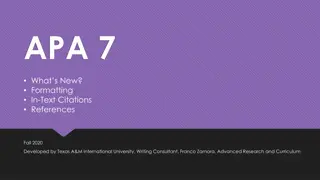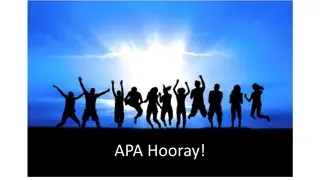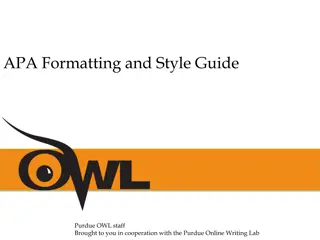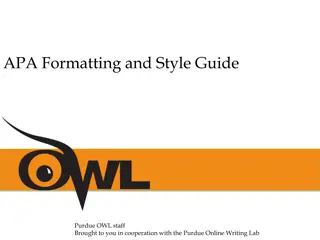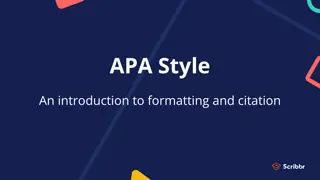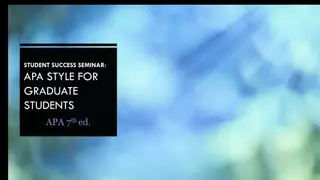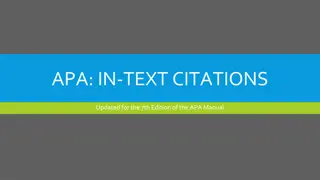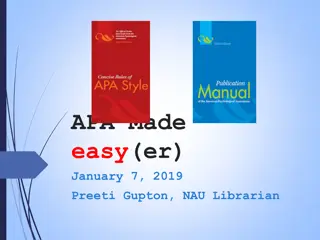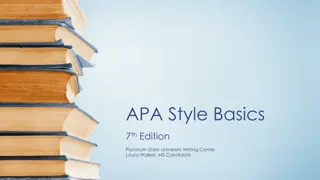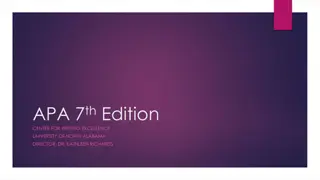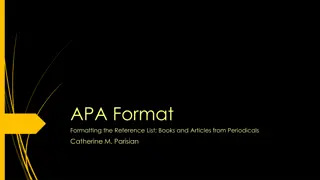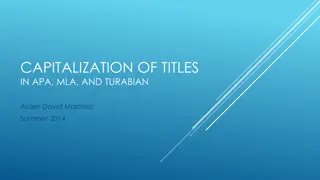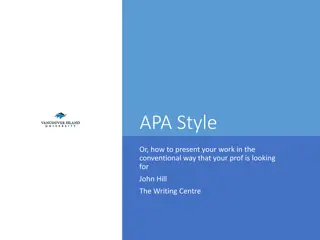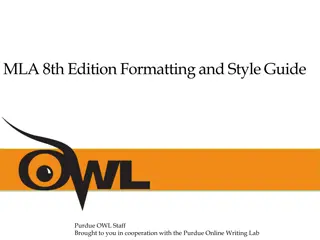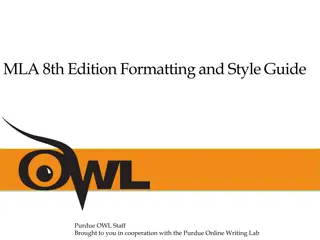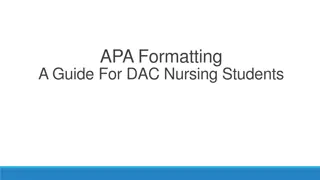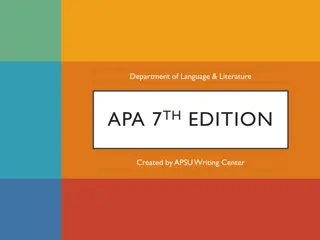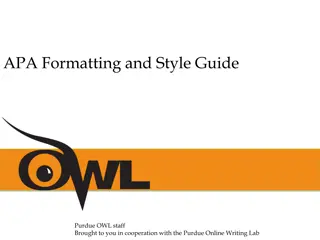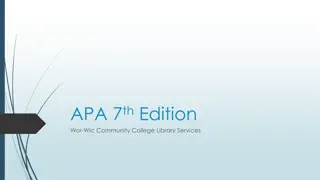APA 7th Edition Formatting Guidelines for Student Papers
Learn the specific rules for formatting student papers in APA 7th Edition, including the title page, headings, and more. Ensure your academic writing meets the required standards with this helpful PowerPoint guide.
Download Presentation

Please find below an Image/Link to download the presentation.
The content on the website is provided AS IS for your information and personal use only. It may not be sold, licensed, or shared on other websites without obtaining consent from the author.If you encounter any issues during the download, it is possible that the publisher has removed the file from their server.
You are allowed to download the files provided on this website for personal or commercial use, subject to the condition that they are used lawfully. All files are the property of their respective owners.
The content on the website is provided AS IS for your information and personal use only. It may not be sold, licensed, or shared on other websites without obtaining consent from the author.
E N D
Presentation Transcript
APA 7thEdition CENTER FOR WRITING EXCELLENCE UNIVERSITY OF NORTH ALABAMA DIRECTOR, DR. KATHLEEN RICHARDS
Rules for student papers are slightly different than a professional paper. This PowerPoint will focus on formatting student papers, including title page, headings, documentation, in-text citations, and other various guidelines. APA for Student Papers
No running head unless instructed by professor or publisher Titles should be in bold type (including title page and title within the paper) More font changes are acceptable Level headings are different For documentation of sources, no city, state of publication is required; the words Retrieved from are no longer needed before URLs APA Changes For in-text citations, if there are 3 or more authors or editors of a source, only the last name of the first author is used, followed by et al
Rules for font sizes are more lenient. a sans serif font such as 11-point Calibri, 11-point Arial, or 10-point Lucida Sans Unicode or a serif font such as 12-point Times New Roman, 11-point Georgia, or normal (10-point) APA for Student Papers
Running head (optional) Title (bold) Title Page Format Author byline Affiliation Due Date
New changes for 7thedition for Title Page: Running head is no longer required unless professor requires one. If professor requires a header, then the following information is needed: Include a running head fewer than 50 characters and are left aligned; capitalize every letter Title Page (headers) The words Running head: no longer appear as a label on the first page Page numbers are still right aligned, with title page as number 1
New changes for 7thedition for Title Page: Titles are placed in the upper 2/3rds of the title page in bold print, center aligned. All words should be capitalized except the following: articles (a, an, the);conjunctions (so, but, nor, and, or, yet, for); prepositions that are three letters or fewer ( examples: on, in, for, at, by, of) Title Page (title information) Titles are normally 12 words or fewer If colons are included in titles, the first letter of the first word should be capitalized Lines should be double spaced
Below the title, type the author byline: first name, middle initial (if applicable), and last name If there is more than one author, then list the authors names in order of their contribution (or alphabetical order), and separate names with a comma. Use and before the last name. Title Page (author information) Example: Whitney Post, Sam Ruitz, and Matt Henson or Matt Henson, Whitney Post, and Sam Ruitz
Level Format 1 Centered, Bold, Title Case Heading Text begins as a new paragraph. 2 Flush Left, Bold, Title Case Heading Text begins as a new paragraph. 3 Flush Left, Bold Italic, Title Case Heading Level Headings Text begins as a new paragraph. 4 Indented, Bold, Title Case Heading, Ending With a Period. Text begins on the same line and continues as a regular paragraph. 5 Indented, Bold Italic, Title Case Heading, Ending With a Period. Text begins on the same line and continues as a regular paragraph. APA (2020)
Invert all individual authors names, providing the surname first, followed by a comma and the author s initials. Example: Author, A. A. Use a comma to separate an author s initials from additional author names, even when there are only two authors. Use an ampersand (&) before the final author s name. Number of Authors Example: Author, A. A., & Author, B. B. Provide surnames and initials for up to and including 20 authors. When there are two to 20 authors, use an ampersand before the final author s name. Example: Author, A. A., Author, B. B., & Author, C. C. When there are 21 or more authors, include the first 19 authors names, insert an ellipsis (but no ampersand), and then add the final author s name. APA (2020)
Write the authors name exactly as it appears on the published work, including hyphenated surnames and two-part surnames. Example: Santos-Garc a, S., & Velasco Rodr guez, M. L. Unique Authors Retain the author s preferred capitalization. Example: hooks, b. van der Waal, P. N. APA (2020)
Reference List Citation: When two authors of the same source share a surname, use first initials with the last names. Ehrlich, P., & Ehrlich, A. (1998). Betrayal of science and reason: How anti-environmental rhetoric threatens our future. Island Press. Two Authors with the Same Last Name In-Text Citation: If multiple authors within a single reference share the same surname, the initials are not needed in the in-text citation; cite the work in the standard author date format. (Ehrlich & Ehrlich, 1998)
On a page from an organizational or government agency website, the organization or government agency itself is considered the author, unless otherwise specified. The author of a webpage or website may also be located on an about us or acknowledgments page. An abbreviation for the group author can be used in the text (e.g., NIMH for National Institute of Mental Health); however, do not include an abbreviation for a group author in a reference list entry. Organization As Author Correct: National Institute of Mental Health. Incorrect: National Institute of Mental Health (NIMH). Incorrect: NIMH. APA (2020)
When numerous layers of government agencies are listed as the author of a work, use the most specific agency as the author in the reference (e.g., use National Institute of Nursing Research rather than U.S. Department of Health and Human Services, National Institutes of Health, National Institute of Nursing Research ). The names of parent agencies not present in the group author name appear in the source element as the publisher. Example: Government Agencies As Author National Institute of Nursing Research. (2015). A family s perspective: Pediatric palliative care stories (NIH Publication No. 15-NR-8018). U.S. Department of Health and Human Services, National Institutes of Health. https://www.ninr.nih.gov/sites/files/docs/ NINR_508c_FamilyStories_0.pdf APA (2020)
Electronic: Jackson, L. M. (2019). The psychology of prejudice: From attitudes to social action (2nd ed.). American Psychological Association. https:// doi.org/10.1037/0000168-000 Print: Print and Electronic Books Sapolsky, R. M. (2017). Behave: The biology of humans at our best and worst. Penguin Books. Parenthetical citations: Narrative citations: From the research of Jackson (2019) and Sapolsky (2017), a clear percentage of .. (Jackson, 2019) (Sapolsky, 2017) APA (2020)
Crimi, C. (2019). Weird little robots (C. Luyken, Illus.). Candlewick Press. Pitman, G. E. (2016). This day in June (K. Litten, Illus.). Magination Press. Slater, D. (2017). The antlered ship (T. Fan & E. Fan, Illus.). Children s Book with Illustrator Different Than Author Beach Lane Books. Parenthetical citations: (Crimi, 2019) (Pitman, 2016) (Slater, 2017) Narrative citations: The research conducted by Crimi (2019), Pitman (2016), and Slater (2017) revealed APA (2020)
Beaton, K. (2016). King baby (K. Beaton, Illus.). Arthur A. Levine Books. Children s Book with Author Same As Illustrator Parenthetical citation: (Beaton, 2016) Narrative citation: Beaton (2016) illustrated the story . APA (2020)
Numeroff, L. J. (2007). If you give a mouse a cookie (F. Bond, Illus.). Laura Geringer Books. (Original work published 1985) Sendak, M. (2012). Where the wild things are (M. Sendak, Illus.; 50th anniversary ed.). HarperCollins Publishers. Republished or Anniversary Addition of a Children s Book (Original work published 1963) Parenthetical citations: (Numeroff, 1985/2007) (Sendak, 1963/2012) Narrative citations: The books by Numeroff (1985/2007) and Sendak (1963/2012) uncover the imagination .. APA (2020)
Print: Kesharwani, P. (Ed.). (2020). Nanotechnology based approaches for tuberculosis treatment. Academic Press. Electronic: Torino, G. C., Rivera, D. P., Capodilupo, C. M., Nadal, K. L., & Sue, D. W. (Eds.). (2019). Microaggression theory: Influence and implications. John Wiley & Sons. https://doi.org/10.1002/9781119466642 Whole Edited Book Parenthetical citations: Narrative citations: According to Kesharwani (2020) and Torino et al. (2019), research reveals . (Kesharwani, 2020) (Torino et al., 2019) APA (2020)
Harris, K. R., Graham, S., & Urdan T. (Eds.). (2012). APA educational psychology handbook (Vols. 1 3). American Psychological Association. Several Volumes of a Multi-Volume Work Parenthetical citation: (Harris et al., 2012) Narrative citation: Harris et al. (2012) declare that the . APA (2020)
Aron, L., Botella, M., & Lubart, T. (2019). Culinary arts: Talent and their development. In R. F. Subotnik, P. Olszewski-Kubilius, & F. C. Worrell (Eds.), The psychology of high performance: Developing human potential into domain-specific talent (pp. 345 359). American Psychological Association. https://doi.org/10.1037/ 0000120-016 Chapter in an Edited Book Dillard, J. P. (2020). Currents in the study of persuasion. In M. B. Oliver, A. A. Raney, & J. Bryant (Eds.), Media effects: Advances in theory and research (4th ed., pp. 115 129). Routledge. Parenthetical citations: (Aron et al., 2019) Narrative citations: Aron et al. (2019) and Dillard (2020) (Aron et al., 2019; Dillard, 2020) APA (2020)
Bronfenbrenner, U. (2005). The social ecology of human development: A retrospective conclusion. In U. Bronfenbrenner (Ed.), Making human beings human: Bioecological Chapter in an Edited Book, Reprinted from Another Book perspectives on human development (pp. 27 40). SAGE Publications. (Reprinted from Brain and intelligence: The ecology of child development, pp. 113 123, by F. Richardson, Ed., 1973, National Educational Press) Parenthetical citations: (Bronfenbrenner, 1973/2005) Narrative citations: Bronfenbrenner (1973/2005) APA (2020)
American Psychiatric Association. (1980). Diagnostic and statistical manual of mental disorders (3rd ed.). American Psychiatric Association. (1987). Diagnostic and statistical manual of mental disorders (3rd ed., rev.). Edition of the Diagnostic and Statistical Manual of Mental Disorders (DSM) American Psychiatric Association. (2000). Diagnostic and statistical manual of mental disorders (4th ed., text rev.). American Psychiatric Association. (2013). Diagnostic and statistical manual of mental disorders (5th ed.). https://doi.org/10.1176/appi.books.9780890425596 Parenthetical citations: (American Psychiatric Association, 1980) (American Psychiatric Association, 2013) Narrative citations: American Psychiatric Association (1980) APA (2020)
American Psychiatric Association. (2013). Anxiety disorders. In Diagnostic and statistical manual of mental disorders (5th ed.). https://doi.org/10.1176/ appi.books.9780890425596.dsm05 An Entry in the DSM Parenthetical citation: (American Psychiatric Association, 2013) Narrative citation: American Psychiatric Association (2013) APA (2020)
World Health Organization. (2016). International statistical classification of diseases and related health problems (10th ed.). https://icd.who.int/browse10/ 2016/en Edition of the International Statistical Classification of Diseases and Related Health Problems (ICD) World Health Organization. (2019). International statistical classification of diseases and related health problems (11th ed.). https://icd.who.int/ Parenthetical citations: (World Health Organization, 2016) (World Health Organization, 2019) Narrative citations: According to the World Health Organization (2016), The World Health Organization (2019) defines .. APA (2020)
World Health Organization. (2019). 2A85.5 Mantle cell lymphoma. In International statistical classification of diseases and related health problems (11th ed.). https://icd.who.int/browse11/l- An Entry in the ICD m/en#/http://id.who.int/icd/entity/1804127841 Parenthetical citation: (World Health Organization, 2019) Narrative citation: World Health Organization (2019) APA (2020)
Grady, J. S., Her, M., Moreno, G., Perez, C., & Yelinek, J. (2019). Emotions in storybooks: A comparison of storybooks that represent ethnic and racial groups in the United States. Psychology of Popular Media Culture, 8(3), 207 217. https://doi.org/10.1037/ Journal Article ppm0000185 Parenthetical citation: (Grady et al., 2019) Narrative citation: Grady et al. (2019) APA (2020)
Jerrentrup, A., Mueller, T., Glowalla, U., Herder, M., Henrichs, N., Neubauer, A., & Schaefer, J. R. (2018). Teaching medicine with the help of Dr. House. Journal Article with an Article Number PLoS ONE, 13(3), Article e0193972. https://doi.org/ 10.1371/journal.pone.0193972 Parenthetical citation: (Jerrentrup et al., 2018) Narrative citation: Jerrentrup et al. (2018) APA (2020)
Missing volume number Stegmeir, M. (2016). Climate change: New discipline practices promote college access. The Journal of College Admission, (231), 44-47. https://www. nxtbook.com/ygsreprints/NACAC/nacac_jca_ spring2016/#/46 Missing issue number Journal Article with Missing information Sanchiz, M., Chevalier, A., & Amadieu, F. (2017). How do older and young adults start searching for information? Impact of age, domain knowledge and problem complexity on the different steps of information searching. Computers in Human Behavior, 72, 67 78. https://doi.org/10.1016/j.chb.2017. 02.038 Parenthetical citation: (Stegmeir, 2016, p. 44) Narrative citation: Sanchiz et al. (2017) APA (2020)
Butler, J. (2017). Where access meets multimodality: The case of ASL music videos. Kairos: A Journal of Rhetoric, Technology, and Pedagogy, 21(1). Journal Article with Missing Page or Article Number http://technorhetoric.net/21.1/topoi/butler/index .html Parenthetical citations: (Butler, 2017) Narrative citations: Butler (2017) APA (2020)
Freeberg, T. M. (2019). From simple rules of individual proximity, complex and coordinated collective Online-Only Supplemental Material to a Journal Article movement [Supplemental material]. Journal of Comparative Psychology, 133(2), 141 142. https:// doi.org/10.1037/com0000181 Parenthetical citation: (Freeberg, 2019) Narrative citation: Freeberg (2019) APA (2020)
A secondary source refers to content first reported in another source. Cite secondary sources sparingly for instance, when the original work is out of print or unavailable. If possible, as a matter of good scholarly practice, find the primary source, read it, and cite it directly rather than citing a secondary source. In the reference list, provide an entry for the secondary source that you used. In the text, identify the primary source and write as cited in the secondary source that you used. If the year of publication of the primary source is known, also include it in the text citation. Information for Documenting Secondary Sources (Rabbitt, 1982, as cited in Lyon et al., 2014) If the year of the primary source is unknown, omit it from the in-text citation. Allport s diary (as cited in Nicholson, 2003)
Lyons, D. (2009, June 15). Don't iTune us: Its geeks versus writers. Guess who s winning. Newsweek, 153(24), 27. Schaefer, N. K., & Shapiro, B. (2019, September 6). New middle chapter in the story of human evolution. Science, 365(6457), 981 982. https://doi.org/ Magazine Articles 10.1126/science.aay3550 Schulman, M. (2019, September 9). Superfans: A love story. The New Yorker. https://www.newyorker.com/ magazine/2019/09/16/superfans-a-love-story Parenthetical citations: (Lyons, 2009) (Schaefer & Shapiro, 2019) Narrative citations: Lyons (2009) Schaefer and Shapiro (2019) APA (2020)
Carey, B. (2019, March 22). Can we get better at forgetting? The New York Times. https://www. nytimes.com/2019/03/22/health/memory-forgetting- psychology.html Harlan, C. (2013, April 2). North Korea vows to restart shuttered nuclear reactor that can make bomb- grade plutonium. The Washington Post, A1, A4. Newspaper Articles Stobbe, M. (2020, January 8). Cancer death rate in U.S. sees largest one-year drop ever. Chicago Tribune. Parenthetical citations: (Carey, 2019) (Carey, 2019; Harlan, 2013; Stobbe, 2020) Narrative citations: Carey (2019), Harlan (2013), and Stobbe (2020) APA (2020)
Ouellette, J. (2019, November 15). Physicists capture first footage of quantum knots unraveling in superfluid. Ars Technica. https://arstechnica.com/ science/2019/11/study-you-can-tie-a-quantum- Blog Post knot-in-a-superfluid-but-it-will-soon-untie-itself/ Parenthetical citation: (Ouellette, 2019) Narrative citation: Ouellette (2019) APA (2020)
joachimr. (2019, November 19). We are relying on APA as our university style format - the university is located in Germany (Kassel). So I [Comment on the blog post The transition to seventh edition APA Style ]. APA Style. https://apastyle.apa.org/ Blog Post Comment blog/transition-seventh-edition#comment- 4694866690 Parenthetical citation: (joachimr, 2019) Narrative citation: joachimr (2019)
For a page from an organizations website without individual authors, use the name of the organization as the author. Provide as specific a date as possible for the webpage. Some online works note when the work was last updated. If this date is clearly attributable to the specific content you are citing rather than the overall website, use the updated date in the reference. Information Needed to Document Websites Do not include a date of last review in a reference because content that has been reviewed has not necessarily been changed. If a date of last review is noted on a work, ignore it for the purposes of the reference. Italicize the title of the webpage. If the author of the webpage and the site name are the same, omit the site name from the source element to avoid repetition. End the reference with the URL. APA (2020)
Bologna, C. (2019, October 31). Why some people with anxiety love watching horror movies. HuffPost. https://www.huffpost.com/entry/anxiety-love- watching-horror-movies_l_ 5d277587e4b02a5a5d57b59e Woodyatt, A. (2019, September 10). Daytime naps once Webpage on a Website or twice a week may be linked to a healthy heart, researchers say. CNN. https://www.cnn.com/2019/ 09/10/health/nap-heart-health-wellness-intl-scli/ index.html Parenthetical citations: (Bologna, 2019; Woodyatt, 2019) Narrative citations: Bologna (2019) and Woodyatt (2019) APA (2020)
Webpage on a Website with an Organizational Group As Author World Health Organization. (2018, May 24). The top 10 causes of death. https://www.who.int/news-room/ fact-sheets/detail/the-top-10-causes-of-death Parenthetical citations: (World Health Organization, 2018) Narrative citations: World Health Organization (2018) APA (2020)
